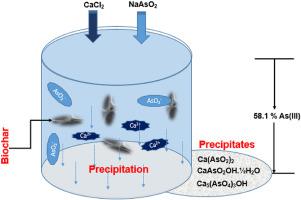当前位置:
X-MOL 学术
›
Environ. Pollut.
›
论文详情
Our official English website, www.x-mol.net, welcomes your
feedback! (Note: you will need to create a separate account there.)
The removal of arsenic from solution through biochar-enhanced precipitation of calcium-arsenic derivatives
Environmental Pollution ( IF 7.6 ) Pub Date : 2021-09-25 , DOI: 10.1016/j.envpol.2021.118241 Eric F Zama 1 , Gang Li 2 , Yu-Ting Tang 3 , Brian J Reid 4 , Ngwa M Ngwabie 5 , Guo-Xin Sun 6
Environmental Pollution ( IF 7.6 ) Pub Date : 2021-09-25 , DOI: 10.1016/j.envpol.2021.118241 Eric F Zama 1 , Gang Li 2 , Yu-Ting Tang 3 , Brian J Reid 4 , Ngwa M Ngwabie 5 , Guo-Xin Sun 6
Affiliation

|
Arsenic (As) pollution remains a major threat to the quality of global soils and drinking water. The health effects of As pollution are often severe and have been largely reported across Asia and South America. This study investigated the possibility of using unmodified biochar derived from rice husk (RB) and aspen wood (WB) at 400 °C and 700 °C to enhance the precipitation of calcium/arsenic compounds for the removal of As(III) from solution. The approach was based on utilizing calcium to precipitate arsenic in solution and adding unmodified biochar to enhance the process. Using this approach, As(III) concentration in aqueous solution decreased by 58.1% when biochar was added, compared to 25.4% in the absence of biochar. Varying the pH from acidic to alkaline enabled an investigation into the pH dependent dynamics of the approach. Results indicated that significant precipitation was only possible at near neutral pH (i.e. pH = 6.5) where calcium arsenites (i.e. Ca(AsO), and CaAsOOH•½HO) and arsenates (i.e. Ca(AsO)OH) were precipitated and deposited as aggregates in the pores of biochars. Arsenite was only slightly precipitated under acidic conditions (pH = 4.5) while no arsenite was precipitated under alkaline conditions (pH = 9.5). Arsenite desorption from wood biochar was lowest at pH 6.5 indicating that wood biochar was able to retain a large quantity of the precipitates formed at pH 6.5 compared to pH 4.5 and pH 9.5. Given that the removal of As(III) from solution is often challenging and that biochar modification invites additional cost, the study demonstrated that low cost unmodified biochar can be effective in enhancing the removal of As(III) from the environment through Ca–As precipitation.
中文翻译:

通过钙砷衍生物的生物炭强化沉淀从溶液中去除砷
砷(As)污染仍然是全球土壤和饮用水质量的主要威胁。砷污染对健康的影响往往很严重,亚洲和南美洲的报道较多。本研究调查了在 400 °C 和 700 °C 下使用源自稻壳 (RB) 和白杨木 (WB) 的未改性生物炭来增强钙/砷化合物沉淀以去除溶液中 As(III) 的可能性。该方法基于利用钙沉淀溶液中的砷并添加未改性的生物炭来增强该过程。使用这种方法,添加生物炭时水溶液中的 As(III) 浓度降低了 58.1%,而没有生物炭时则降低了 25.4%。通过将 pH 从酸性变为碱性,可以研究该方法的 pH 依赖性动力学。结果表明,只有在接近中性 pH 值(即 pH = 6.5)时才可能出现显着沉淀,其中亚砷酸钙(即 Ca(AsO) 和 CaAsOOH•½H2O)和砷酸盐(即 Ca(AsO)OH)以聚集体形式沉淀并沉积在生物炭的孔隙。在酸性条件(pH = 4.5)下仅轻微沉淀亚砷酸盐,而在碱性条件(pH = 9.5)下没有亚砷酸盐沉淀。木质生物炭中亚砷酸盐的解吸在 pH 6.5 时最低,表明与 pH 4.5 和 pH 9.5 相比,木质生物炭能够保留在 pH 6.5 时形成的大量沉淀物。鉴于从溶液中去除 As(III) 通常具有挑战性,并且生物炭改性会带来额外成本,该研究表明,低成本的未改性生物炭可以通过 Ca-As 沉淀有效增强从环境中去除 As(III) 。
更新日期:2021-09-25
中文翻译:

通过钙砷衍生物的生物炭强化沉淀从溶液中去除砷
砷(As)污染仍然是全球土壤和饮用水质量的主要威胁。砷污染对健康的影响往往很严重,亚洲和南美洲的报道较多。本研究调查了在 400 °C 和 700 °C 下使用源自稻壳 (RB) 和白杨木 (WB) 的未改性生物炭来增强钙/砷化合物沉淀以去除溶液中 As(III) 的可能性。该方法基于利用钙沉淀溶液中的砷并添加未改性的生物炭来增强该过程。使用这种方法,添加生物炭时水溶液中的 As(III) 浓度降低了 58.1%,而没有生物炭时则降低了 25.4%。通过将 pH 从酸性变为碱性,可以研究该方法的 pH 依赖性动力学。结果表明,只有在接近中性 pH 值(即 pH = 6.5)时才可能出现显着沉淀,其中亚砷酸钙(即 Ca(AsO) 和 CaAsOOH•½H2O)和砷酸盐(即 Ca(AsO)OH)以聚集体形式沉淀并沉积在生物炭的孔隙。在酸性条件(pH = 4.5)下仅轻微沉淀亚砷酸盐,而在碱性条件(pH = 9.5)下没有亚砷酸盐沉淀。木质生物炭中亚砷酸盐的解吸在 pH 6.5 时最低,表明与 pH 4.5 和 pH 9.5 相比,木质生物炭能够保留在 pH 6.5 时形成的大量沉淀物。鉴于从溶液中去除 As(III) 通常具有挑战性,并且生物炭改性会带来额外成本,该研究表明,低成本的未改性生物炭可以通过 Ca-As 沉淀有效增强从环境中去除 As(III) 。











































 京公网安备 11010802027423号
京公网安备 11010802027423号